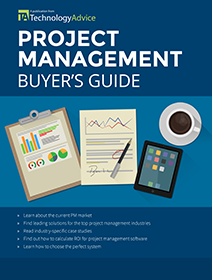The expected role of project management (PM) is to put processes in place that minimizes failure and increases the odds of success. Grounding the business with project management is comforting for an organization and helps ensure predictability. If something goes wrong after establishing set guidelines, either the process wasn’t followed or the process is flawed.
The rigid nature of traditional PM, and the predictability it seeks to generate, is often at odds with the key to business success: innovation. This doesn’t mean project management is unnecessary or merely interference. Ensuring projects are finished on time, on budget, and within scope is always a necessary challenge.
In this article...
Re-imagining Project Management with Innovation in Mind
The focus here is the intersection between innovation and project management. Innovation is complex and unpredictable, and it takes time to realize. Project management bridges the gap across workstreams and can help make innovation more predictable.
The challenge is finding a strategy that allows for oversight, but doesn’t stifle creativity. The following are five novel ways businesses are re-imagining project management while encouraging creativity and ideation.
1. Choosing and using the right project management methodology
Every project is unique and can benefit from a specific project management methodology to achieve best results. Knowing what to do, in what order, and by when is only part of the puzzle. And plugging that plan into a process or framework will give you the support you need to succeed.
Technical projects, like software development or engineering efforts, are often run in an agile framework to iteratively progress smaller complicated pieces that require a continuous testing and improvement conveyor belt.
Comparatively, creative projects are better suited to a waterfall or stepped process when something needs to be completed before the next part can begin. For example, a GUI or interface may need to be designed and approved before functionality and features can be developed that utilize that digital space.
And sometimes, a hybrid approach may be best for work that includes both technical and creative aspects, such as a website, an online course, or a video game.
Choosing an appropriate project management methodology to implement before a project kicks off will keep things moving along and aligned with requirements post kick off to produce a successful end product. Winging it and using a loose barely-there style of management will probably present a situation riddled with gaps, delays, and unhappy customers when the budget gets spent too soon and results in a subpar product.
2. Build in time and scope to experiment and fail
Testing culture is often confined to software development, and large high-tech firms allocate a generous percentage of time to employees for working on personal interest projects that benefit the company.
But, building experimentation into other departments is also important for true innovation. Stricter and less traditionally creative departments like sales, marketing, and even finance need the flexibility and space to run tests and explore innovative answers to business questions.
However, the problem with today’s project management culture is that it’s so pervasive that tasks and initiatives that don’t get assigned don’t get done. If you want to build a culture of innovation, reserve time and mental space for experiments, and make employees responsible for sharing their findings.
You can build experimentation into your project management culture by:
- Building dedicated testing time into each employee’s week;
- Scheduling project sharing sessions where teams can collaborate on the success of creative projects; and
- Celebrating failures as well as wins and reviewing lessons learned.
So, there is a trade-off that your company will need to balance with your managers and employees, and you may consider testing and experimentation policy before rolling it out company-wide.
Although, allowing the time for workers to experiment with ideas outside of traditional projects can improve work overall and benefit the company in many ways. Giving them a voice instills confidence and the ability to step outside of traditional roles to participate in interesting work and help build a better tomorrow.
3. Simplify the process with the right PM tools
The advent of robust project management tools has allowed many different project team members to enter data, track progress, and report on results. An emerging trend is that companies are eschewing traditional management hierarchies and adopting a flat management structure with decision-making left to multiple people.
No longer are senior managers making the strategic decisions with tasks delegated down the chain of command. Instead they are using project management software that helps increase communication and collaboration. These tools empower employees to self-organize projects from start to finish and turn their own innovative ideas into reality.
There is a tool for every team or sometimes multiple tools that integrate with your current infrastructure. Automating time-consuming tasks like planning, scheduling, tracking, and resource allocation frees up time for work to get done and for more innovation to take place.
Moreover, complex projects require close planning, tracking, and collaboration in order to be successful. Project management tools can provide the necessary functions to make these endeavors a success without risking innovation.
4. Drive Inspiration with Time
To balance out day-to-day work and required meetings and efforts to run the business, give back some time for learning and growing. The people behind the business will benefit the bigger picture most when they are growing professionally.
Be sure to build in time during the weeks or months for professional learning opportunities. Additionally, provide space for experimenting with new ways of doing things, and encourage them to share their ideas.
There is no better feeling than being a part of something new, making change, and authoring ideas that matter. Making something your own inspires loyalty and commitment and a reason to get out of bed in the morning and contribute to something that has your mark on it.
5. Learn from past mistakes and successes
Once the product is out the door, the site is launched, or the update is implemented, take the time needed to unwind and reflect. All projects offer a lessons-learned opportunity.
Encourage conversation and feedback from everyone involved through a post-project review. Give all involved the opportunity to speak up about what worked and what could be avoided next time or done better. More importantly, take that advice and apply it to future projects.
Those involved will be candid about their experience when it went exceptionally well or ran off the rails at some point. Like a product review, those with strong feelings will want to be heard. Take the good and the bad and apply it to future work to improve next time.
Finding Balance Between Accountability and Creativity
Finding a happy balance in your organization’s project efforts can be difficult. While it’s important to keep projects in check with scope and budget restrictions, it’s just as important to encourage opportunities for innovation.
By implementing these strategies, you will be able to instill accountability across teams while allowing for periods of creativity.
NOTE: This story was updated in June 2022 by Anne Meike.

